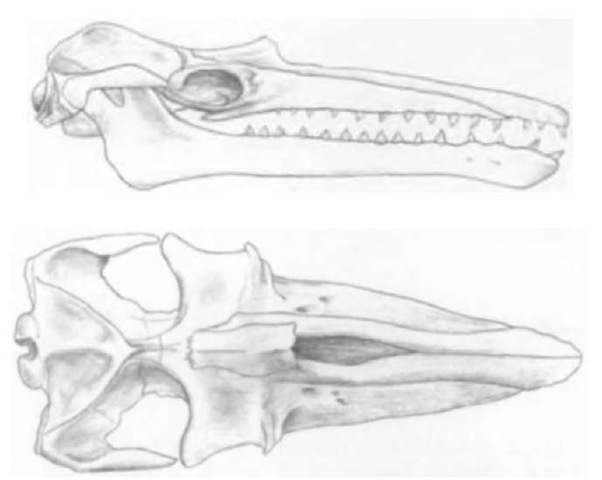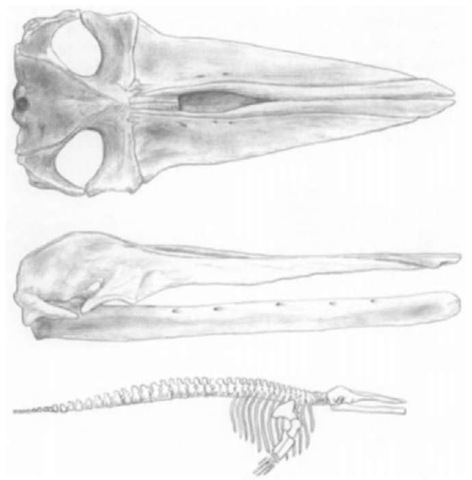The modern mysticetes (baleen whales) are typically charge acterized by the development of specialized epithelial * tissue in the roof of the mouth that becomes keratinized: the so-called baleen. The baleen is used to filter organisms from water or sediment, ranging in size from microscopic cope-pods to crustaceans and fish as much as 5 cm in length. There is evidence for baleen in whales dating from the Oligocene, but some archaic mysticetes retained functional teeth all the way to the late Oligocene. Modern baleen whales do not have functional teeth, although incipient teeth are found in embryos. Archaic baleen whales are considered to be those mysticetes, both toothed and baleen-bearing, that do not belong to extant families. They comprise four named families: Mammalodonti-dae, Llanocetidae, Aetiocetidae, and Cetotheriidae, with over 20 named genera.
Modification of the rostrum is a characteristic of even the earliest mysticetes. The rostral elements extend backward to the orbits and are expanded laterally, while at the same time the occipital region extends forward. The telescoping of the skull also occurs in odontocetes, but there is an asymmetry in these forms, and the rostral elements tend to overide the frontals.
The remainder of the skeleton of mysticetes is greatly simplified. The mandibular symphysis is lost, with the two den-taries held together by a ligament. The sternum is greatly reduced. The hindlimbs are almost totally absent, the only remnant being a small splint of bone thought to be homologous with the pelvis, which no longer articulates with the vertebral column. There are trends toward compression, and ultimately fusion, in the cervical vertebrae and reduction of rib-vertebrae articulations.
I. Origins and Affinities
Although typically considered as a monophyletic group distinct from the odontocetes, certain molecular studies have indicated that mysticetes are the sister group to physeterids (sperm whales) and nested within a paraphyletic Odontoceti. This relationship was first suggested on the basis of mitochondrial ribosomal DNA sequences. However, other molecular studies (DNA-DNA hybridization, karotypes, and cytochrome DNA sequences) support the more traditional, morphology-based classification. Further support for odontocete and mys-ticete monophyly comes from studies of the inner ear of a number of Miocene and Pliocene “cetotheres” that shows that they did not have the high-frequency hearing that permits echolocation, and which is so typical of odontocetes.
Recent discoveries indicate that baleen whales evolved directly from archaeocete ancestors. The Llanocetidae from the late Eocene or early Oligocene of the South Pacific are het-erodont and may have used their denticulate and palmate cheek teeth for filter feeding. Other primitive mysticetes from the late Oligocene of South Carolina include two heterodont genera but with skull development similar to later baleen whales. Homodont toothed mysticetes are seen in the Aetiocetidae (Fig. 1), also from the late Oligocene. This group was quite diverse, with eight species in three genera described to date. The aetiocetids retain marginal teeth in both upper and lower jaws, yet exhibit the loose mandibular symphysis, which is a characteristic feature of all later mysticetes. Another late Oligocene form is Mammalodon, which has an unusually short rostrum unlike any other mysticete.
Even though these toothed mysticetes are too young to be actual ancestors to the cetotheres, which also dated from the early Oligocene, they may indicate the pattern of mysticete evolution. The earliest fossils of baleen-bearing whales come from the early Oligocene of New Zealand. While baleen does not fossilize, the pattern of skull vascularization in these earliest members is consistent with those of living mysticetes.
II. Diversification of Mysticetes
The earliest records of both odontocetes and mysticetes are in early Oligocene sediments of New Zealand. While in the Northern Hemisphere cetaceans are commonly considered to have had limited diversity during Oligocene times, in the Austral realm both odontocetes and mysticetes radiated, while at the same time the archaeocetes declined. These radiations have been attributed to a series of major geographical and climatic changes. First, during the latest Eocene and earliest Oligocene major continental glaciations developed, probably together with sea ice, which resulted in marked temperature drops in the oceans. At the same time with the opening of the Drake Passage between Antarctica and South America the Circum-Antarctic Current was established. Coupled with the initiation of the psychosphere this brought about increases in local upwelling and areas of high productivity offshore. This may have led to the development of a filter-feeding lifestyle in the mysticetes and the eventual appearance of baleen.
Figure 1 Aetiocetus polydentatus, an aetiocetid from the late Oligocene Morawan Formation of Japan. Top, skull and mandible, left lateral view. Bottom, skull, dorsal view. Length of skull approximately 55 cm. After Barnes et al. (1994).
Thus by the middle Miocene the mysticetes had peaked in diversity, with some 15 known genera compared to only 5 today. Moreover, the modern whales are largely characterized on the basis of external features. Clearly this is not possible with fossil forms, and it might be argued that solely on the basis of skeletal morphology that certain modern whales species would not have been separated as fossils. On this basis, and assuming that fossil forms also exhibited similar external variation, then the diversity of the Miocene cetotheres may have been even greater than is usually considered.
Most early mysticetes (particularly those from the late Oligocene to early Pliocene) are included in a single family, the Cetotheriidae (Fig. 2). However, this family has been acknowledged to be a “catch-all” assemblage of different taxa that really reflects our poor understanding of the early evolution of baleen whales. Cetothere species are mostly differentiated on the basis of skull proportions and, in some cases, differences in the ear region. No clearly derived shared characters have been recognized in any cetotheres that would permit a better understanding of the relationships within this family.
The cetothere grade whales still exhibit strong vertebral-rib articulations and do not have fusion of the cervical vertebrae. The cervicals tend to be quite compressed, and the hindlimbs are apparently absent. The skull is relatively smaller in the cetotheres than in the modern mysticetes, and the rostrum tends to be broad and tapering, making it more similar in outline to that of the Balaenopteridae and Eschrichtiidae than the Bal-aenidae. Cetotheres are also quite small. Body lengths in the Miocene range from about 3 m up to about 11 m (although only one specimen greater than 10 m is known). In modern mysticetes, adult body lengths are from 6 to 30 m, but only three species are normally less than 12 m.
Figure 2 Parietobalaena palmeri, a cetothere from the middle Miocene Calvert Formation of Maryland and Virginia. (Top) Skull, dorsal view. (Middle) Skull and mandible, lateral view. (Bottom) Skeletal reconstruction. Length of skull approximately 120 cm. A and B after Kellogg (1965).
Cetotheres have a worldwide distribution with a number of well-established genera, usually based at least on partial skulls. From eastern North America are Pelocetus, Parietobalaena, Agalocetus, Diorocetus, Metopocetus, “Mesocetus,” Thinocetus, Halicctus, and Cephalotropis. From western North America are Parietobalaena, Agalocetus, Herpetocetus, Tiphyocetus, Peripolocetus, and Cophocetus. South American genera include Morenocetus, Agalocetus, and “Plesiocetus.” European genera include Mesocetus, Herpetocetus, Isocetus, Cetotheriopsis, and Cetotherium. Imerocetus and Cetotherium are known from the Tethyan realm. From New Zealand is Mauicetus and from Japan is Herpetocetus. In addition, there are several unnamed specimens from most of these areas, some of which may represent new genera. There are also many nominal genera based on fragmentary remains.
III. Emergence of Modern Mysticete Fauna
The first members of some modern groups appeared in the middle part of the Miocene. These faunal changes may be correlative with worldwide environmental change and physical changes in the oceans. Among these changes were the establishment of a West Antarctic ice sheet, closure of the western opening of the Mediterranean Sea, and closure of the Indo-Pa-cific Seaway, all of which may have contributed to cooling, steeper temperature gradients and more complex ocean current patterns. In turn this would have resulted in a variety of pelagic habitats and increased partitioning of food resources. Thus in the same way that major changes in ocean currents resulted in the radiation of the “archaic” mysticetes (cetotheres) during the early and middle Oligocene, another major shift in ocean currents and sea temperatures could have initiated the radiation of modern mysticetes and brought about the demise of the archaic forms.
It is generally thought that all four modern mysticete families have separate origins among the cetotheres, but this is still speculative. The modern baleen whales [Balaenopteridae (rorquals and humpback whale, Megaptera novaeangliae), Bal-aenidae (right whales), Eschrichtiidae (gray whale, Eschrichtius robustus), and Neobalaenidae (pygmy right whale, Caperea marginata) all have have derived characters not presently known from any cetothere. All the modern families have weak-to-absent rib-vertebrae articulations and skulls which represent at least 25% of the body length. The balaenopterids have maxillary spurs that extend posteriorly along the top of the skull, and the supraorbital portions of the frontals are depressed well below the top of the skull. Eschrichtius has enlarged nasals and posterior ends of the premaxillae, a moderately arched rostrum, and posterior maxillary processes similar to balaenopterids, and there is no coronoid process on the mandible. The balaenids are perhaps the most divergent mysticetes, with an extremely arched and narrow rostrum, an anteroposteriorly compressed cranium, divergent zygomatic processes, the supraoccipital extending to a point anterior to the orbit, and fused cervical vertebrae. Caperea (Neobalaenidae) has a rostrum less arched and broader than in balaenids, although the supraoccipital extends anterior to the orbit. The balaenids and balaenopterids have fossil records extending to the Miocene, but it is not clear how they are related to the cetotheres. Caperea is thought to be close to the balaenids, but it does not have a fossil record. Eschrichtius is known only from the Quaternary. The body proportions of Eschrichtius are more similar to the cetotheres than to other modern mysticetes, and they still have strong rib articulations and a relatively long neck, making this genus more primitive than any of the other modern mysticetes.
Research programs on Oligocene and Miocene mysticetes are very active and new finds are continually being made. For example, additional finds from the Oligocene of New Zealand, Japan, and South Carolina will help shed further light on the origin of baleen whales from the archaeocetes, and exciting new discoveries in Virginia promise to elucidate separate lineages within the cetothere grade. One new Miocene cetothere appears to be more derived than other contemporary cetotheres in having compressed cervical vertebrae and exhibiting reduction of the capitulum. Furthermore, characters of the periotic indicate affinities with modem balaenopterids.


